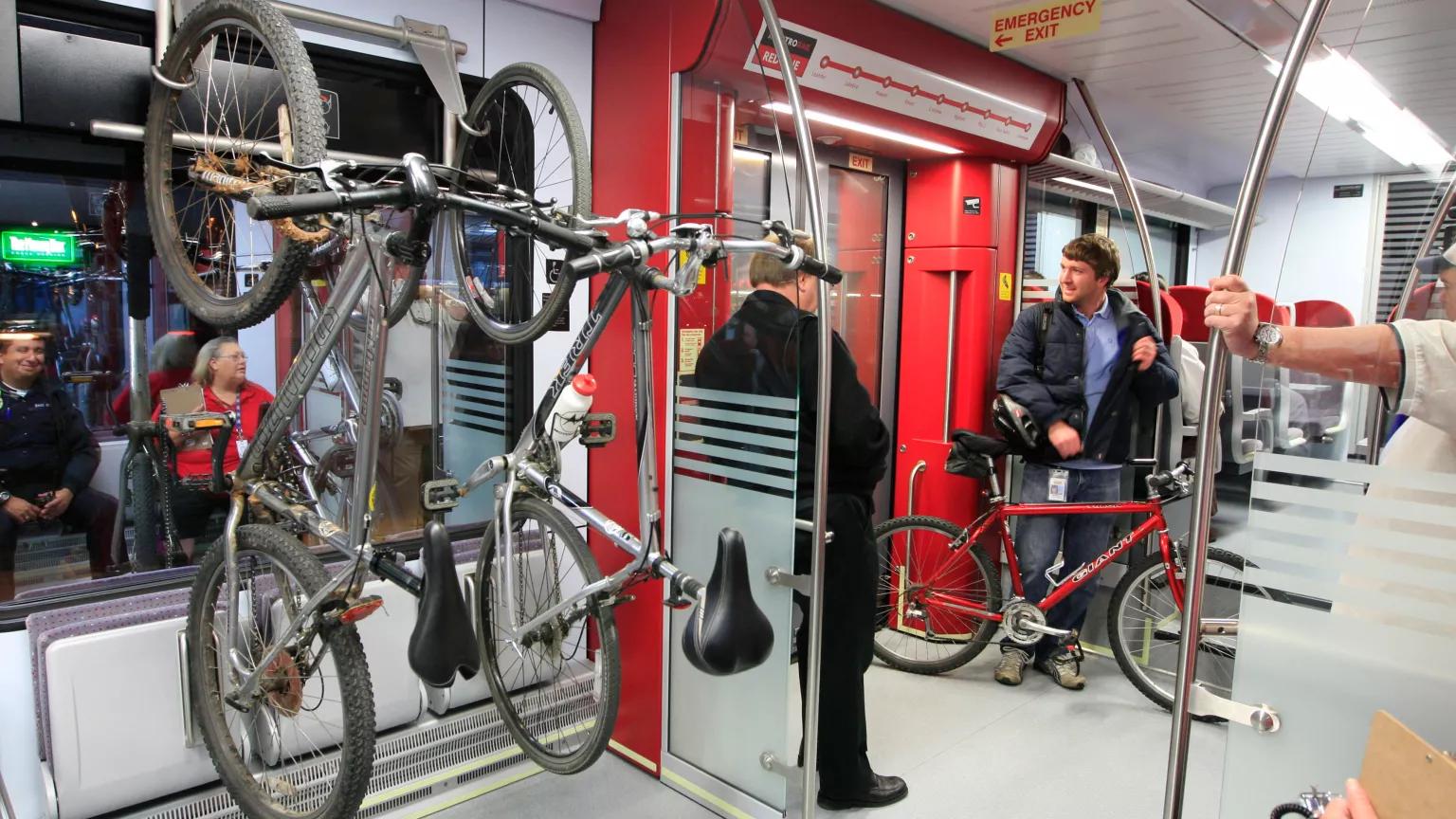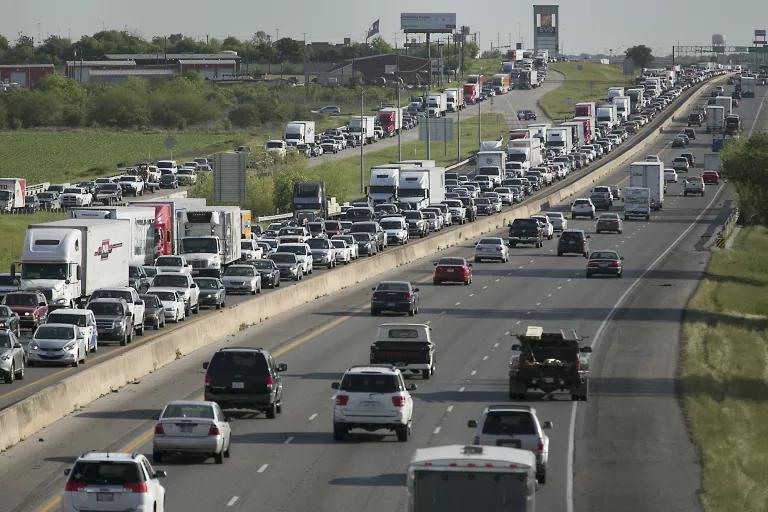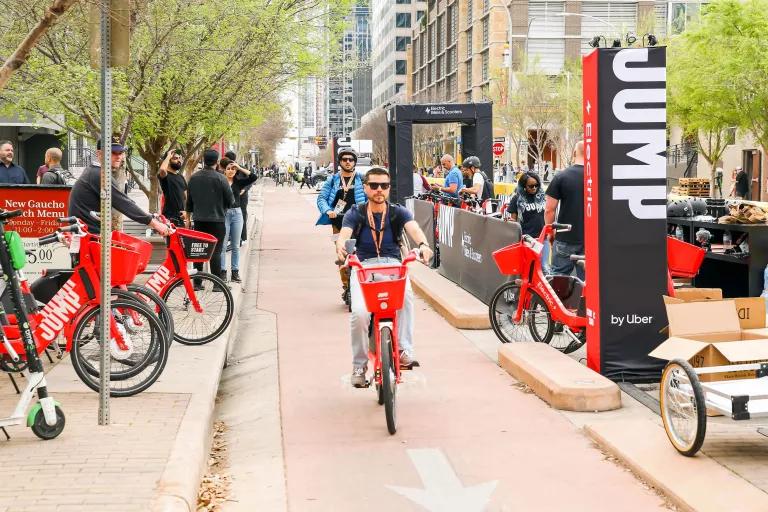How Austin Plans to Grow—Without Adding More Cars to Its Roads
By tackling transit, ride sharing, and more, the Texas capital hopes to embrace its big-city identity.

Commuters on the Capital Metro in downtown Austin
Bob Daemmrich/Alamy Stock Photo
Austin is used to being bold. Whether it’s air- and water-quality protections, species and habitat conservation, renewable energy and green building, or, now, responding to the climate crisis, Austin residents have consistently embraced strategies that meet these challenges head on. Except for one big thing: how they get around town.
Unlike Dallas and Houston, or peer cities like Denver or Salt Lake, Austin has balked at making transformative investments in public transit. Twice, in 2000 and 2014, Austin voters rejected plans to build a light-rail system, swayed by opponents claiming rail would “cost too much and do too little,” while proponents argued among themselves about whether the plans on offer were really the best Austin could do. The Capital MetroRail Red Line, a single-line commuter service on old freight tracks, swung into service in 2010 but currently carries fewer than 3,000 riders a day on its 32-mile route between downtown and the northwest suburb of Leander. Although it’s currently being double-tracked to increase train frequency, the Red Line services a mere 3 percent of the transit authority’s total ridership.
That’s not to say Austin’s mobility systems are completely outmoded. In 2017, Capital Metro remapped its bus service routes to attract more of the city’s commuters, its nearly 100,000 college students, and its 27 million annual visitors. Meanwhile, the city’s Complete Streets policy has made the city friendlier to pedestrians and bicyclists, with more and better sidewalks, bike lanes, and walking trails, all while Austin rolls out bike, scooter, and e-bike rental programs with gusto. In addition, major local employers—in government, education, technology, health care, and hospitality—have been faithful supporters of carpooling, teleworking, and ride sharing.
Still, these efforts haven’t done enough to get most of the city’s commuters out from behind the wheel. Transportation accounts for almost 5 million tons of greenhouse gas emissions annually in Austin (36 percent of its carbon footprint), and if Austin is going to reach its climate goals, reducing emissions from this sector will be necessary. The city certainly has its work cut out for it: In the 2015 Austin Community Climate Plan, officials pledged to achieve net-zero greenhouse gas emissions by 2050. Making transportation more climate-friendly is also a key tenet of the Austin Strategic Mobility Plan (ASMP), adopted in April. Through that plan, city officials are seeking to put in place a “‘big-city’ transportation network to meet our big city needs.” The transit-intensive scenarios presented in both plans all presume Austin will build new high-capacity, congestion-free transit systems that will capture several hundred thousand trips now being made by car.

Traffic on I-35 near the outskirts of Austin
Ralph Barrera/Austin American-Statesman via AP
But first a culture shift is in order. That’s why Austin identified “changing commuting behavior” as a major objective when it was named a winner of the Bloomberg American Cities Climate Challenge, an initiative in partnership with NRDC and other organizations. Leading the push is Mayor Steve Adler, who in his four and a half years in office has persuaded his constituents to “go big” and approve nearly $1 billion in mobility projects to create “complete streets” and improve bus service in a dozen urban corridors. Having won reelection in a landslide last November, Adler now plans to throw as much of his substantial political capital as possible at finally getting Austin on the path to high-capacity transit. “I think we can give people greater transit choices, with greater reach and frequency,” he says. “We need a system that is cheaper and better than always getting in a car. We have to deliver better and better options, so that people will like them and start using them.”
Adler and the city council organized the ASMP around the primary objective of reaching “50/50 mode share” among commuters by 2039. Right now, the mode split is 75/25—meaning three-quarters of Austin adults drive alone to work or school, while the rest use a combination of transit, walking, biking, teleworking, and ride sharing. If the proportion of nondrivers can be doubled, city experts say, Austin can keep the number of cars on its roads (and the miles they travel) level, even as the city grows.
Fortunately, the city isn’t starting from scratch. In 2012, downtown leaders took the initiative to create the region’s first transportation management association, known as Movability. The nonprofit works with major employers to create incentives for their workers to stop driving alone, even if just once in a while. In 2015, the city began hosting an annual Smart Mobility Summit, and in 2016, it was selected as a finalist for the U.S. Department of Transportation’s Smart City Challenge. Meanwhile, Capital Metro’s Project Connect, which plans high-capacity transit around the region, is now working to craft a proposal—which could incorporate rail, bus rapid transit, and autonomous vehicles, all presumably electrified—to go to voters in November 2020.

Attendees of the 2019 South by Southwest festival getting around Austin on electric bikes and scooters
Diego Donamaria/Getty Images for SXSW
Since Project Connect would take years to bear fruit, Adler doesn’t dismiss the value of smaller, interim steps. One example he touts is the city’s rapid adoption of dockless electric scooters. In their 14 months on Austin’s streets, though they’ve attracted some skepticism, the scooters have made an astounding almost five million trips—nearly three times the ridership of Metro Rail—averaging a mile each, with zero emissions. Some of those trips are recreational, but many are not. The scooters have replaced short auto trips, provided first- and last-mile service to transit users, and allowed better parking management—all attributes of the “big city network” the ASMP envisions. Currently, eight operators (including Bird and Lime) have deployed approximately 15,000 vehicles citywide, concentrated downtown, around the University of Texas at Austin campus, and in other high-traffic zones. (The National Association of City Transportation Officials, which has been tracking scooter adoption, reports that in 2018, 40 percent of all U.S. scooter trips took place in Los Angeles, San Diego, and Austin.)
Green transit advocates believe that once the infrastructure is built, the city’s commuters will be quick to make use of it. Their confidence is well founded: Even as Austin has boomed and sprawled, its jobs have remained notably concentrated in the city center. Specifically, more than 125,000 jobs are found in the adjacent areas of the downtown business and entertainment district, the Texas State Capitol complex, and the University of Texas campus. What’s more, housing in those areas has grown significantly in recent years, so a critical mass of commuters could benefit from enhancements to the in-city transit network.
City leaders now have their eyes on a future in which fewer and fewer people are opting to drive solo into downtown, and they have begun to calibrate investments in mobility infrastructure. Parking is no longer required by code in the central business district, and several large new projects—notably hotels—have opted to devote fewer floors to garage parking, which encourages visitors to skip the car and find other means of getting around town. Meanwhile, Capital Metro is rebuilding its Downtown Station, the terminus of the Red Line. By 2021, when passengers disembark there, as they do for conventions and huge events like the South by Southwest festival, they’ll be able to take advantage of a major mobility hub for rail, buses, ride sharing, scooters, bikes, pedestrians, and future high-capacity transit.
Adler hopes this consistent pattern of change is a sign that the time has come to make the big transit jumps that will transform Austin into a big city. “It’s a chicken-and-egg thing, but I think the people are really motivated now,” he says. "There are still a lot of loud voices saying that we should do nothing”—or advocating for only one particular small change—“but they’re seeing their old level of influence ebb. They’re the voices of a day long gone.”
This NRDC.org story is available for online republication by news media outlets or nonprofits under these conditions: The writer(s) must be credited with a byline; you must note prominently that the story was originally published by NRDC.org and link to the original; the story cannot be edited (beyond simple things such as grammar); you can’t resell the story in any form or grant republishing rights to other outlets; you can’t republish our material wholesale or automatically—you need to select stories individually; you can’t republish the photos or graphics on our site without specific permission; you should drop us a note to let us know when you’ve used one of our stories.

How to Stop a Highway
Urban Innovator
How You Can Stop Global Warming